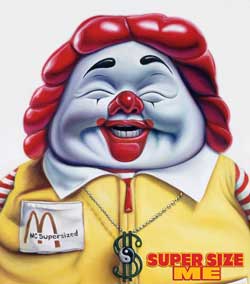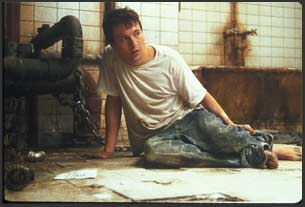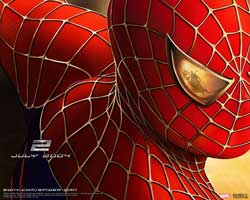Managed to catch Super Size Me the other night.
Basically, Morgan Spurlock does a Michael Moore on the American fast food industry.
He sets himself the task of eating McDonald’s 3 times a day for a month, and super sizes every meal when offered while taking a critical look at America’s culture of obesity.
In America, and elsewhere, there is an obesity crisis. People are simply so fat that it damages their health. Legions of overweight consumers munch through vast portions of sugary, fatty food.
The outrage is that while some in the world starve others die from chronic overfeeding.
Go to an average McDonald’s restaurant and you’ll be offered small, medium, large and super-size portions.
The fast food drinks are huge and are often sold in buckets. The ‘double gulp’, not from McDonald’s, holds an astounding half gallon of soda containing a staggering 48 teaspoons of sugar.
Within a few days, Morgan Spurlock is complaining of what he calls McTummy, the McStomach ache, the McSweats and the McStomach brick.
The huge portions of junk food are making him feel awful. At one point he vomits out of the car window before he can finish his super-size meal.
You soon start to feel for him as he chews his way through 3 squares a day of McDonald’s.
After only 9 days, the menu inevitably gets boring and he suffers depression and finds it really hard going. The thought of McDonald’s morning, noon and night for a month does not appeal !
McDonald’s lure in kids by providing playgrounds, children’s birthday parties and happy meals.
Their marketing emphasises fun at McDonald’s restaurants and their motif is a very recognisable clown.
They target children.
I remember as a child growing up in America in the 70s, a trip to McDonald’s was a special treat. We lived just outside Washington DC and my parents would drive out to the local mall on the Leesburg Turnpike. I remember the McDonald’s there. It had a strange ornamental statue surrounded by thin wires with flowing droplets of oil. Thinking back it was a bit weird. But, hey, it was the 70s !
We would happily tuck into burgers and fries and pester Mum and Dad for more. The golden arches were etched in my young mind as a place of food and fun.
Interestingly, Morgan Spurlock interviews some marketing guru who describes something called ‘brand imprinting for actuation later in life’.
Basically, introduce the brand to children as fun and happy to ensure the logo and brand values stick in their mind. The same ideas as candy cigarettes ! The theory goes that a child who eats candy cigarettes will be more likely to smoke as an adult.
Evil stuff. But it seems to work.
So, McD’s are looking to give kids such a good time that they become lifelong customers.
The impact of all this fast food and super-sized culture is a doubling of obesity in children and adolescents in America in the last 20 years.
This leads to a whole host of diseases and medical conditions including liver problems and diabetes. Basically, too much fast food makes you ill.
Too many fat teenagers and obese children face serious threats to their health by eating junk food. As one contributor put it, ‘you can’t deny these links’.
The programme continues with a look at processed food and Mcdonalds’ ceaseless marketing drive.
McNuggets are termed ‘McFrankenstein’ creations of salt, fat, sugar and processed meat. What goes into them is unclear. But they are manufactured and processed beyond belief.
America has been McDonaldised out and franchised to death. Everywhere you look the golden arches have a ubiquitous presence. McDonald’s is everywhere.
The average US child sees 19,000 food adverts a year. Convenience food and fast food chains are being promoted like never before. It’s big business.
In 2001, McDonald’s alone spent $1.4billion on direct advertising worldwide. Think of all the t-shirts, coupons, kids toys, promotions, TV ads and posters. The McDonald’s brand seems omnipresent.
I’m loving it ! Not.
Any investigation into the diet of American kids has to include school lunches. Here Morgan Spurlock gets close to what Jamie Oliver did to British school dinners.
Both are horrified at the terrible state of the food served up to our school children. School kids are served reheated, reconstituted, packaged foods. Most of which is provided by huge industrial catering companies like Sodexho.
Both Jamie Oliver and Morgan Spurlock discover that diet effects classroom behaviour. In Appleton, Wisconsin, a special needs school serves up fresh ingredients with no frying. No candy or soda is available and the staff are amazed by the changes in behaviour. The kids are more focussed and better behaved. Exactly what Jamie Oliver discovered with his new fresh menus served in Greenwich schools.
Morgan Spurlock takes medical advice and had a full check up before starting out on his McDonald’s eatathon. He soon discovers that his new diet is providing over 200% of his actual nutritional needs. In only 12 days he’s gained a staggering 17lbs. He is soon feeling sick and unhappy as the effects of his high fat diet kick in. His blood pressure reaches 150 over 90 and he starts to talk about a strange addiction to McDonald’s food. His mood goes up and down, but once he starts eating his depression seems to lift. At one point he wakes suddenly at 2am, short of breath suffering heart palpitations.
His medical advisors start to warn his endeavour is rapidly turning into a dangerous experiment. They advise him to stop and warn of the risk of gout, kidney stones and a pickled liver.
Essentially, his liver is deteriorating into pâté. One even advises him to call an ambulance if he starts to feel bad.
His team calls over 100 nutritionists and 95% confirm that junk food is a major contributor to the current obesity epidemic. However, the American food industry is protected by powerful lobby groups in Washington which ensure a favourable Congress. They have enormous power and influence over votes and policy.
By the end of the month Morgan Spurlock has gained 24.5lb and consumed a total of 30lb of sugar and 12lb of fat.
It’s easy to see McDonald’s customers simply as dumb consumers of cheap mass produced burgers and fries. Addicted to huge portions of sugary, fatty food which makes them obese.
In McDonald’s defence, they have dropped the super size option, added salads and healthier options to their menus and publish full nutritional information. Even though it’s sometimes hard to find in their restaurants.
No one is forced to eat McDonald’s and no one really eats it 3 times a day, every day. Too much of anything will make you sick.
However, Morgan Spurlock’s experiment highlights a real problem in a dramatic way. The fast food restaurants are serving up vast portions of cheap, fatty food which is causing obesity and illness among their customers.









